
in creating a people-friendly city.
(Photos © J. Maus)
In America, there are many unseen barriers to creating a more human-friendly transportation system. Many of them reside in national engineering manuals that were created — and continue to be “updated” — by auto-centric engineers. Other barriers are entrenched in policies and processes at those familiar bastions of the status quo; state-level Departments of Transportation.
Among the many powerful transportation planning tools that the Oregon DOT holds jurisdiction over is setting speed limits on city streets. It should go without saying how vital speed limits are in creating a bike and pedestrian-friendly city. High-speed, arterial streets — especially through residential areas, where even a 35 mph speed limit feels unsafe — are often the location of very serious collisions.
So what happens when planners and engineers at the City of Portland want to lower a speed limit to make a street safer? The bureaucracy kicks in and ODOT holds all the cards.
As Portland works to create a network of streets that are more friendly to people who walk and bike, one of the key ingredients they’ll need to use is to bring down speed limits. Unfortunately, many local projects have been delayed (bikeway improvements on N. Rosa Parks Way to name one) because of the process the City of Portland must go through in order to alter a speed limit.
Mayor Sam Adams believed that having local oversight of speed limits was important enough to include in his first 100 days to-do list. Adams had promised to “lobby for a bill giving cities jurisdiction over speed limits.” He didn’t do that, but what Adams did do was to draft a letter about the issue to the director of ODOT, Matt Garrett.
In the letter, dated May 19th, Adams wrote that he wants to work with Garrett to make the current speed limit regulation process (which he stated is “problematic” for the City), “safer, more efficient, and more cost-effective.”
Here’s how Adams lays out the problem:
Currently, as laid out in statute and Oregon Administrative Rules, in order to alter the speed limits on streets within city limits, the City of Portland must go through a sometimes lengthy process to determine the appropriate speed limit for every individual street. While the end result could often be predetermined by previously approved speed limits of streets that share the same fundamental traits, the City is required to request a new study for each street segment and the State is then required to conduct duplicative studies for every request. We would like to streamline this process.
Adams points out that the current speed limits are set in an “ad-hoc” fashion, often in response to citizen complaints. This, says Adams, creates “problems in terms of city planning as well as enforcement, and the inconsistencies create confusion among drivers, which can lead to a greater degree of speed violation.”
To remedy the situation, Adams suggests a pilot project that would allow Portland greater flexibility in setting local speed limits.
At this point, it’s just a letter, but the impact of speed limit policy on creating a bike-friendly city cannot be understated. We hope ODOT director Garrett will take heed of the letter and the suggestions. Portland has a very bike-sensitive regional director in Jason Tell, and a Portland pilot project sounds like a great first step.


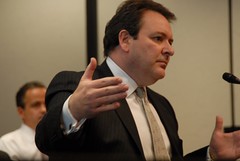
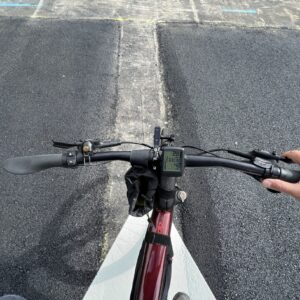
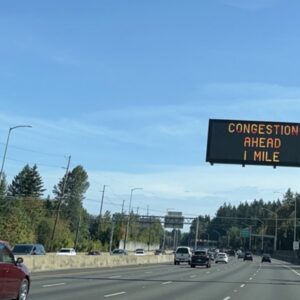
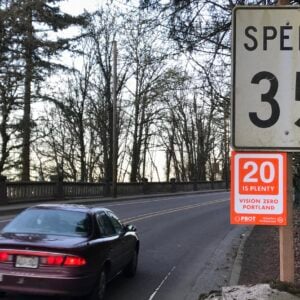
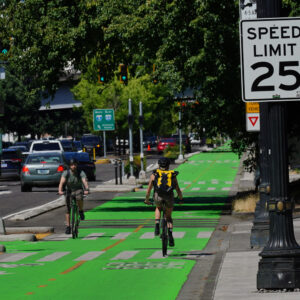
Thanks for reading.
BikePortland has served this community with independent community journalism since 2005. We rely on subscriptions from readers like you to survive. Your financial support is vital in keeping this valuable resource alive and well.
Please subscribe today to strengthen and expand our work.
Speed limits have very little to do with overall driving speeds. Lower speed limits amount to nothing more than a “feel good” approach to accommodating bicycle traffic. According to the FHWA, altering speed limits changes overall travel speeds by no more than 1-2 mph, depending on the road.
Roadway geometry and line of sight have a lot more to do with travel speeds. It should be noted that narrowing lanes and installing speed humps reduces safety. Conversely, widening shoulders to accommodate cyclists and improving pavement markings improve bicycle as well as car safety.
As a cyclist, I want cars to make a quick safe pass around me and not be distracted by simply trying to adhere to a low speed limit. Studies have shown when low speed limits are enforced in neighborhoods, pedestrian accidents actually increase as they may feel emboldened to walk in front of moving traffic.
It is time that the cycling community quit trying to legislate auto behavior and begin looking to modify certain traffic laws that go contrary to cycling interests. A bicycle is NOT a car and although operating on the same road, the same rules need not apply.
Laws are irrelevant unless they’re enforced.
And the PPB already does not effectively enforce the existing speed limits.
So, why would giving PBOT control over speed limits make any street in Portland more safe? Adams’ approach is flawed.
What we need is a change in the law to allow mobile photo radar units to issue speeding citations. That is currently illegal under Oregon law and would actually produce compliance with the current limits.
People tend to drive 5 to 10 miles over the limit so lowering limits can have an impact despite lack of enforcement, but your point is well taken.
Aside from the issue of local control, it seems like the process should be different and easier if the desire is to lower the speed limit as opposed to raising it.
#1: “Studies have shown when low speed limits are enforced in neighborhoods, pedestrian accidents actually increase as they may feel emboldened to walk in front of moving traffic.”
Please provide a citation to support this assertion.
#2 “That is currently illegal under Oregon law and would actually produce compliance with the current limits.”
The above statement is not correct. Photo radar is allowed in Portland (and other Oregon cities). See ORS 810.438 & 810.439 http://www.leg.state.or.us/ors/810.html
I have a ticket to prove that photo radar is allowed here. In all honesty, it is quite impressive. It had three pictures; one of my license plate, of of my car and one of my face.
#5: Thanks for that. I misspoke. Note that 810.439(1)(a)(A) requires that a uniformed officer operate a photo radar device used to issue a citation for speeding. This effectively makes mechanized use of photo radar illegal. And practically, it means that photo radar cannot be used effectively in enforcing speed limits. The PPB does not have the resources to station an officer with every mobile photo radar device.
Thus, my point in #2 stands with that added nuance.
Damnit, I misspoke again. The statement “This effectively makes mechanized use of photo radar illegal.” should be “This effectively makes mechanized use of photo radar to enforce speed limits illegal.”
Ad hoc is right. The busiest part of NE Alberta is 30, which seems crazy fast to me (with my driving hat on). On the other hand, NE Fremont near 45th is 20–it’s a similar area to Alberta but spans less blocks and is less dense.
Driving through those areas just the other day, I couldn’t understand why they’d be different, but it’s just politics and bureaucracy as usual.
Any similar retail zone should automatically have a 20 mph limit (or even 15). In addition to being safer, it’s more business friendly.
Henry #1 “Studies have shown when low speed limits are enforced in neighborhoods, pedestrian accidents actually increase as they may feel emboldened to walk in front of moving traffic.”
this is the same type of “emboldening” argument that traffic engineers use against providing marked pedestrian crosswalks. Yet it’s my experience that if you want drivers to stop for you to cross the street they’re far more likely to do it if you have a marked crosswalk.
I, too, would like to see a citation for Henry’s assertion.
@Henry, it seems like most people will stay below 10mph over the speed limit (not including freeways, though often there, too), which indicates that reducing limits would have an impact. Also, at lower speeds, there’d be no need to pass cyclists in many cases.
I’ve been wondering too if higher residential or retail zone speed limits actually help people get anywhere any faster. Due to traffic and lights and parking and what not, it doesn’t seem to affect my average travel time whether I drive 20 or 30 (or 15) in these areas. Of course, with our current tailgating mentality, this seems counterintuitive, but it seems like going slower in certain cases might actually help us get there faster.
Henry-
please link to some data backing these claims up!
thanks
Traffic moves painfully slow in Portland already. I am a cyclist but I do not agree with lowering the speed limits. 15 miles/hour is too slow on a bike. It takes me 40 minutes to get from the north side to the south side of Portland due to the poor street design. I do not understand why people feel the need to slow down everyone just because they feel uncomfortable.
It is much more effective to create streets that accommodate both bikes and cars. Cars are not going away. The best solution is to keep bikes separate from cars as much as possible. On that note, keep bikes separate from people. Anyone walking on the springwater corridor during commuting hours is bound to have a close call with an agro bike commuter.
On a slight tangent: a friend of a friend back in NH tried to fight a speeding ticket based on the argument that the town was keeping speed limits artificially low in order to generate revenue from speeding fines. She lost the court case, but I believe there is a solid constituency of people who are working to establish a legal precedent based on this concept.
There are many good reasons for reducing residential speed limits beyond biking safety. (Although that’s a very good one!) The quality of life issues of neighborhood traffic noise and pollution are big ones for me. Their motivations are slightly different but check out the 20s Plenty movement over in the UK.
Speeding is a major issue these days,i’m tring to get the Police to see this in my town. 35mph,45mph some roads have high
traffic.
This past weekend riding with my little girl, almost hit about 4 times in a 1.5 mile range. red light runners and speeders rolling up on us fast. Kids freeze when they think a car will not stop.
just my 2cents
Joe
Henry (#1) – You’re correct that speed limits have little to do with actual speeds, but they have a LOT to do with which engineering treatments can be applied to a certain streets. Those treatments in many cases *do* have an impact on actual speeds.
I spent several years on a motor bike with a bicycle computer attached that gave me average speeds. Per tank of gas, about 150 miles, the average speed was amazingly consistent at 25 mph. It really did not matter how aggressively I rode, and even if highway trips were included in the mix, or lots of slow downtown traffic, 25 mph was the magic number. The illusion of speed is hypnotic.
Coyote-
I agree that travelling around town it is hard to beat 20 mph, maybe 25 is feasable if you are really travelling fast. it would be interesting to note that on a bike i can average 15-20 on some routes, so perhaps that motor isn’t necesisary :). On an ideal highway commute, when travelling at off-peak times, i can average 50-55mph for my entire trip, which is 20 miles and i drive it 3-5 times/week and this is 90% of the miles i travel so i would like to claim that i am able to average >25mph in my car. Non-highway trips seem to make the care useless though because of the reasons you described
Matt has a point, to which I would say the next step is: just change the engineering treatments and eliminate speed limit signs. Make the street difficult to drive above 20mph, but don’t tell people what speed to drive – let them figure it out.
changing a sign is easier than modifying the roadway and cheaper and we’re broke!
re comment 14.
traffic moves “painfully” slowly already? where? other than some congested intersections during rush hour, I am not seeing this.
there is no reason why any road should be posted above 30 within the city limits. dropping the limit to 20 or even 15 in an area in which there is (or could be) a lot of pedestrian traffic — Alberta was mentioned above — makes perfect sense, and frankly even a cyclist would rarely want to go above 15 in a pedestrian-heavy environment.
how far north to how far south is it taking you 40 minutes? and where does “poor street design” figure into your delays? bad pavement? not on the major thoroughfares. badly timed lights? probably indirect routing, as only a handful of streets actually cross over the interstate.
I actually do feel comfortable biking on the highly trafficked streets — Sandy, MLK, etc. — but lower limits would nonetheless be helpful because people tend to assume that a posted limit (or five above) is by definition “safe,” when actually a considerably lower speed should be indicated by conditions.
in the long view, cars are in fact “going away,” but in the meantime it is not true that “the best solution is to keep bikes separate from cars as much as possible.” the best solution is to make bikes and pedestrians such a significant part of the traffic mix that motorists will have to take account of them.
aggro bike commuters should stay off the recreational trails.
Don’t forget that lowering the speed limit for a street applies to cyclists as well as drivers.
Speeding? IN PORTLAND? You’re kidding, right?!?!
My list of things I hate about Portland is short. Near the top is the mind numbingly passive approach drivers take here. They drive incredibly slow with 15 mph being their default pace everywhere but the interstate (where they often crawl at 45 mph). They sit at 4-way stop signs staring with a blank yet somewhat serene look on their face waiting for everyone to first come to a complete stop before the negotiations begin on who should dare first enter the intersection. They’re so paranoid about bicycles and loath anything resembling acceleration that they’ll pace behind them for blocks upon blocks waiting for an enormous gap to appear to pass. I’ve been known to pass people on Alberta and the dazed looks of indignation are priceless if not misplaced.
I hate the drivers in this city. The speed limits as they currently are would be just fine if people would use the damn gas pedal and -gasp- pay attention. I’m not asking anyone to speed or drive recklessly. I am asking that they approach driving and riding as a shared experience where you need to be alert and focused.
@are:
“there is no reason why any road should be posted above 30 within the city limits.”
Encouraging this sort of mentality will actually increase speeding on residential streets not designed to handle such traffic. Having city thoroughfares such as Mclaughlin, Sandy Blvd, or 39th Ave E, where drivers can easily reach outlying residential neighborhoods at a moderate and quick speed is smart urban planning. Freeways simply can’t be constructed everywhere and getting drivers into residential zones without encouraging them to speed on any given street is smart planning.
Honestly, the problem is that cyclists are often encouraged to mix with this traffic on thoroughfares not designed to handle that traffic, putting them at risk. These thoroughfares need proper bike lanes and traffic laws on secondary streets need to be better enforced.
Cars and cyclists should be able to coexist just fine without radically altering laws or roadways. Lowering all speed limits on all streets isn’t solving a damn thing. It’s just dumb.
Maybe the city should just repave the rough spots on Davis, Everett, Ankeny, Salmon, etc, and flip a few more stop signs, so that cyclists can actually go fast on the bike boulevards. Currently, with the exception of Lincoln and Ankeny, most of them are full of potholes and warped pavement, and have stop signs posted almost every couple of blocks. That’s why I ride on Burnside, Stark, Belmont, etc. If the lower traffic streets actually facilitated a fast trip for cyclists — even while inhibiting through auto traffic — I might use them more and the arterials less.
Pass a law, declare victory, ignore the lack of results = definition of politics…
We had a mayor in West Palm Beach, FL, who went on a traffic calming binge. He took residential streets that were two lanes in each direction and reduced them to two one lane in each direction, added speed “tables” made of brick, and stuck traffic furniture everywhere.
That turned it from a situation where most cars could pass you without delay to streets that were too narrow for them to pass without crossing the centerline.
And, of course, those bricked humps are slippery when wet and are already starting to pothole.
He spent money to put speed bumps on streets that were so potholed that you couldn’t go fast anyway.
He also narrowed one street and put an extra-wide sidewalk on ONE side and marked it a bike path. Instead of being on a wide street, now you would have to ride against traffic with driveways every few feet.
You want to calm traffic? Stop paving the roads and go back to gravel; that’ll slow it down.
Changing the speed limit is irrelevant unless there is enforcement to go along with it. In England they liberally use photo radar with an interesting backlash; the citizens burn and destroy the photo units by the hundred.
I would suggest taking a different tact. When you are driving your car (i know taboo) just drive the speed limit. If 5 or 10% of people drive the limit this will slow everyone else behind you to just below the speed limit. This will back up into side streets and have a fairly large calming effect over a wide area. It just takes a relative few people to make this work and would be much more effective than changing the numbers on a sign.
ps, what are the Portland Blvd. projects that are on hold?
Lowering the speed limit to 20 on all the bike boulevards in town would have the added benefit of making them that much less attractive for motor vehicles. I have often thought that posting these streets as having a lower speed limit would be at least as effective as speed bumps at a much lower cost if it wasn’t so hard to get done.
I wonder if Portland has to go through ODOT to put a diverter in a street? If not that is a strange setup, they can permanently close an intersection to motor vehicles on their own but they have to commission a study to lower the speed limit 5mph…
btw Jonathan, do you know how often the requests are approved/denied?
Lowering all the speed limits is a knee jerk reaction to larger issues. Lowering speed limits on main thoroughfares pushes vehicles off into residential side streets. Once these streets get inundated with unnecessary stop signs, speed bumps and ridiculous speed limits (20 mph is crazy slow for any well paved modern road) push cars even deeper and farther from the main thoroughfares. Keep the main auto routes flowing, raise the limit on these when applicable, lower those on bike paths, and have consistency with speed limits throughout the city. Traffic patterns for all vehicles should be designed to flow, not grind to a halt so that bikers can feel ‘safe’ as opposed to actually being safe.
lowering speed limits may push traffic onto other streets, but (a) I doubt it and (b) if the other streets also have lower limits, the net result is still slower speeds and maybe less congestion here and there. the total distance from somewhere in the near southwest to somewhere way the h*ll out in the northeast (taking Sandy as the example) is only ten or twelve miles. so even if you were able to sail through the whole distance at 45 mph without stopping (which I hope is a completely unrealistic scenario), it would take you a quarter of an hour. at 35 mph, which is I think the posted limit, your time (again without lights or congestion) would be a little over 20 minutes. take it down to 30 mph, and you have about 25 minutes. if you are saying this is a big issue with motorists, all I can say is, “what”?
lowering speed limits may push traffic onto other streets, but (a) I doubt it and (b) if the other streets also have lower limits, the net result is still slower speeds and maybe less congestion here and there. the total distance from somewhere in the near southwest to somewhere way the h*ll out in the northeast (taking Sandy as the example) is only ten or twelve miles. so even if you were able to sail through the whole distance at 45 mph without stopping (which I hope is a completely unrealistic scenario), it would take you a quarter of an hour. at 35 mph, which is I think the posted limit, your time (again without lights or congestion) would be a little over 20 minutes. take it down to 30 mph, and you have about 25 minutes. if you are saying this is a big issue with motorists, all I can say is, “what?”
Motor vehicle speed is the key variable in the injury level inflicted on pedestrians and bicyclists in crashes. Reducing speed is a no brainer for making neighborhood and business districts safer for all users.
No way should ODOT dictate to the City the speeds of theses streets; only state highways in the City should have input from ODOT.
Bikeways (we have no Boulevards) should be posted 15 mph to discourage cut-thru motor vehicle traffic…”cheaters.” This problem must be addressed if you want to turn stop signs.
Business districts should be posted and enforced at 20 mph, with especially strong enforcement of pedestrian ROW laws. Pull PPB traffic cops off the bicycle harassment beat and put them to good use protecting the most at risk users of our public streets.
Freeways actually carry more traffic at 45mph than at higher speeds due to distance between vehicles.
Sam’s letter is a start.
“Bikeways (we have no Boulevards) should be posted 15 mph to discourage cut-thru motor vehicle traffic…”cheaters.””
I see. So not only do you want to increase travel time for motorists, but you also want to increase travel time for cyclists — at current speeds, half of all cyclists would be in violation on a 15 mph street.
jack (#26) – Encouraging that sort of mentality will only increase speeding in the short term. Given a large enough campaign, like MADD back in the 80s, and the political will to back it up, it could actually work. If the speeds of all vehicles were actually kept under 35, except on limited access highways, and the road engineering supported those lower speeds, enforcement becomes reasonable.
Back that with weight-based penalties and confiscation and auction of vehicles whose operators exceed the speed limit, and you’d have some laws with real teeth.
And I’m fine with that applying to cyclists – bikes are much less damaging than cars in an impact situation, and in most cases it’s cheaper to replace a bike that has been confiscated and sold than the replace a car. I’d imagine those with the $3,000+ carbon-fiber bikes would disagree… (as would Vanilla owners, and half the other custom framebuilder owners)
There’s some room for negotiation here, but it’s a good starting point for discussion.
I certainly support cities being able to reduce street speed limits. The posted speed of too many streets allow motor vehicle speeds that make the experience of walking, biking or living next to such streets…terrible and sometimes dangerous; the noise, the dirt kicked up, the stress.
Just try to enter or cross some of these streets where there isn’t a crosswalk light: you can feel that you’re life is at risk. I think these are some of the reasons that so many people are averse to traveling outside the motor vehicle.
20 mph should be more that fast enough for a lot of streets that currently allow faster speeds. Sure, there are people that can handle and are comfortable with higher motor vehicle speeds on secondary streets and thoroughfares, but we’re not all like those people.
15 mph on Bikeways, not on arterials with bike lanes, is in keeping with the design goals and purposes of these lower traffic, residential streets for all modes…skaters, walkers, bicyclists.
I would argue for 30 mph maximum on arterials, going to 20 mph in business districts…which is close to what have now. It is primarily residential streets that need to be lower, whether Bikeways or not.
Never mind posted limits–nobody’s talking about enforcement. A speeding violation should be treated as the threat to life that it is. Let’s start by raising fines–a speeding ticket should be a significant financial hardship. Let’s reclassify motor vehicle operators as less than human in the eyes of the law–when driving our cars, we should all fear police. We should fear police enough so that it causes us to look to any and all other conveyances. It’s 2009. Our air is getting dirtier, oil is getting scarcer, and the word “automobile” appears nowhere in the US Constitution.
Some of y’all talk as if just lowering a speed limit will substantially change driver’s behavior in a country (and a culture) where people drive at a speed they think is safe and the laws have always been built around recognizing that fact — and the fact that a minority act outside that general rule…and for them speed limits are needed.
They also talk as if we didn’t have a history of towns deciding to raise funds via speed traps…which state speed zone laws and investigations are meant in part to combat.
Think about it people. How long will any politician last if they start setting speed limits that the vast majority of drivers find unnecessarily low?
Enforcement is completely noexistent. As someone mentioned, the 20 mph zone on NE Fremont (41st to about 50th) is ignored. The only police I see in the area are congregating at Starbucks. There are too many pedestrians and businesses for traffic to be moving at 40+ on that stretch. I say, set up a speed trap, increase revenues for awhile and slow down these yahoos who are under the illusion that they are actually important and have to be somewhere fast.